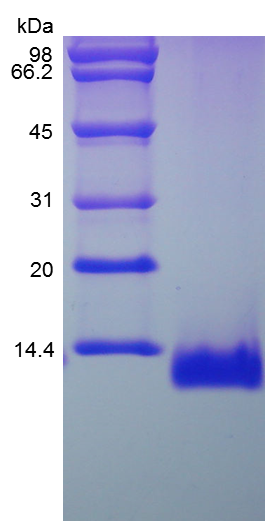- Synonyms
- Small-inducible Cytokine A11
- Source
- Escherichia coli.
- Molecular Weight
- Approximately 8.4 kDa, a single non-glycosylated polypeptide chain containing 74 amino acids.
- AA Sequence
- HPGSIPTSCC FTMTSKKIPN TLLKSYKRIT NNRCTLKAIV FKTKLGKEIC ADPKKKWVQD ATKHLDQKLQ TPKP
- Purity
- > 96 % by SDS-PAGE and HPLC analyses.
- Biological Activity
- Fully biologically active when compared to standard. The biological activity determined by a chemotaxis bioassay using purified eosinophils is in a concentration range of 0.1-1.0 μg/ml.
- Physical Appearance
- Sterile Filtered White lyophilized (freeze-dried) powder.
- Formulation
- Lyophilized from a 0.2 μm filtered concentrated solution in 20 mM PB, pH 7.4, 150 mM NaCl.
- Endotoxin
- Less than 1 EU/μg of rRtEotaxin/CCL11 as determined by LAL method.
- Reconstitution
- We recommend that this vial be briefly centrifuged prior to opening to bring the contents to the bottom. Reconstitute in sterile distilled water or aqueous buffer containing 0.1 % BSA to a concentration of 0.1-1.0 mg/mL. Stock solutions should be apportioned into working aliquots and stored at ≤ -20 °C. Further dilutions should be made in appropriate buffered solutions.
- Stability & Storage
- Use a manual defrost freezer and avoid repeated freeze-thaw cycles.
- 12 months from date of receipt, -20 to -70 °C as supplied.
- 1 month, 2 to 8 °C under sterile conditions after reconstitution.
- 3 months, -20 to -70 °C under sterile conditions after reconstitution.
- Usage
- This material is offered by Shanghai PrimeGene Bio-Tech for research, laboratory or further evaluation purposes. NOT FOR HUMAN USE.
- SDS-PAGE

- Reference
- 1. Ponath PD, Qin S, Ringler DJ, et al. 1996. J Clin Invest. 97:604-12.
2. Jose PJ, Griffiths-Johnson DA, Collins PD, et al. 1994. J Exp Med. 179:881-7.
3. Garcia-Zepeda EA, Rothenberg ME, Ownbey RT, et al. 1996. Nat Med. 2:449-56.
4. Kitamura K, Singer WD, Star RA, et al. 1996. J Biol Chem. 271:7412-5.
- Background
- CCL11 encoded by the gene CCL11is belonging to the CC chemokine family. It is a potent eosinophil chemoattractant that was originally purified from bronchoalveolar lavage fluid of guinea pigs sensitized by aerosol challenge with ovalbumin. CCL11 is a strong and specific eosinophil chemoattractant in vitro. It can directly chemotactic for eosinophils, but not for monocytes or neutrophils. CCR3 has been identified to be a specific CCL11 receptor. CCR3 has also been shown to serve as a cofactor for a restricted subset of primary HIV viruses and binding of CCL11 to CCR3 inhibited infection by the HIV isolates.







 COA申请
COA申请
